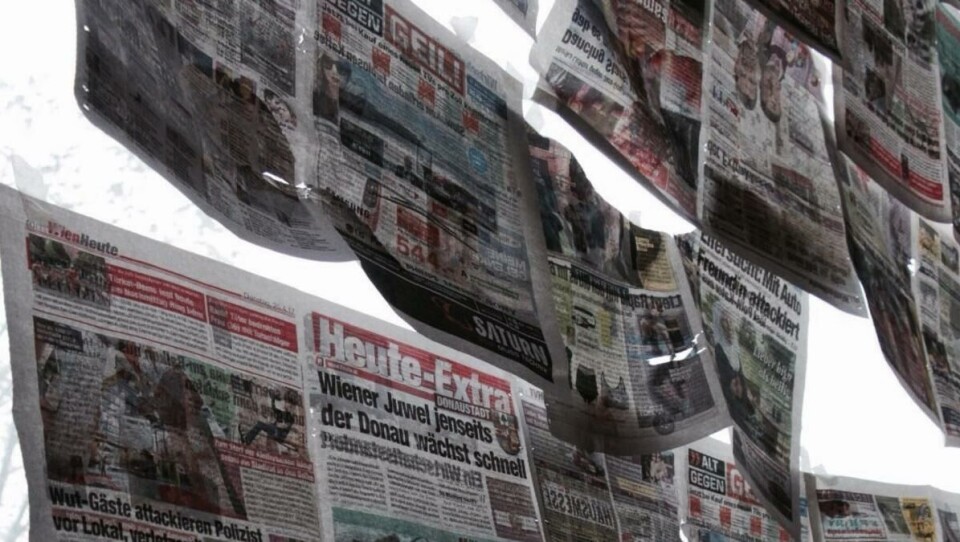Bombarded by News:

How to Maneuver a News-Bombardment
As the war in Ukraine unfolds, many people’s newsfeeds explode. Every minute a new report on developments at the frontlines lets the hope for peace in the war-riddled country diminish.
Not only are the lives of countless people at stake, but also the psychological well-being of those that have to watch in disbelief from afar. How to handle the seemingly endless number of ever worsening news? How to make your way through the confusion of the battle between competing media outlets over the news-primacy?
Since the end of February this year, the news is occupied with the one topic that lets the whole world hold its breath: the Russian invasion of Ukraine. The last time a war of that scale had reached the European continent, radios were the most recent development when it came to news-technology, while the long-standing supremacy of the newspaper was dwindling. To stay informed, people were glued to their radios, which blared out the latest headlines read out by an anchorman, whose voice was crooked almost beyond recognition. Commuters on public transport had their eyes fixed on the newspaper they had just bought from a paperboy on the street. It was essential to get hold of the day’s newspaper, because “there is nothing older than the news of yesterday”.

Catching up on the ongoings once a day via one chosen news channel - be it radio or a newspaper - probably was sufficient for most people to be up-to-date about the state of the world. Consulting the news in this frequency or only relying on a singular news source today will most likely be written off as the behavior of someone closing oneself off from the world. However, this indifference is not more or less dangerous than the constant news-checking on the other side of the spectrum of news-consumption. The eyes glued not to the newspaper, whose fresh ink leaves the readers’ fingers covered in a black hue, but rather to the brightly shining screen on the smartphone. Nowadays one can consume more news in the duration of one bus ride than people did in the course of a week or even month just a century ago. So much to take in, so much to process, so much to wrap your head around.
The over-consumption of news can do serious harm to one’s state of mind. Especially bad news, as they can bring about restlessness, constant worry or even the heavy feelings of fear and despair. The gear of the news-machinery is running ever more smoothly when the normal course of action in everyday life is left. Disaster-porn and fake news appeal to the emotions with their fear-forging, sensation-seeking and conventions-challenging headlines, thereby mentally gripping the news-consumers and dragging them further down the rabbithole of their news-feeds on social media and online. A rule of thumb to break out of the emotions-driven news-cycle that will ultimately leave the head spinning is to seek news that are presented in a rational, sober manner, stripped of as much of emotional appeal as possible and left to appear almost like a “boring” paper.
No matter the length of the text or audio-file, no matter the measurement of the picture or video: what should be clear to the consumer is the central message that the one who has published or posted it wants to transport.
But no one wants to read boring news! More and more people even don’t want to read the news. Media-outlets draw on a myriad of studies showing that humans do not respond as strongly to text and tables or facts and figures as to pictures and photos. What lies at the core of those studies is this: the more and stronger the visual stimuli, the more likely the reader is to respond to the news offer. News agents increasingly put these findings into action by relying heavily on visual material for covering the world’s events.

An informative, valuable news-text, however, will manage to convey its message without the extensive use of heart-wrenching or shock-inducing photos. What an outstanding written news piece can do, however, is to give its reader envision what it describes by the simple mean of letters. Being confronted with a written piece that appears to be composed of photos with some accompanying text should ring an alarm bell to the attentive news-consumer. Trying to avoid getting lured into the consumption of news that is not as informative as it could and should be, but is targeting the readers’ emotional weak spots via photos online can be done relatively easy by changing the browser settings so that no pictures on websites will be shown except for when explicit permission is given. Inquiring into the circumstances, under which a photo has been taken, at what time, where and by whom may help in connecting the dots between the written text and the accompanying visual material.
In times like ours when linear, audiovisual media are relegated by multi-channel, on-demand ones, the approach of avoiding picture-dominated written news is only a tiny drop on a hot stone. The lump of news in the form of 30-minute-long evening-news programs or hour-long debates needs to be broken up into smaller, more valuable bite-sized nuggets of information. News outlets are advised to diversify their services by making them available on an array of social media platforms, each of which needed to be catered to with a different mode of interaction. No matter the length of the text or audio-file, no matter the measurement of the picture or video: what should be clear to the consumer is the central message that the one who has published or posted it wants to transport.
Many already feel as if they were suffocating under the amount of news and information reaching them each day, each hour, each minute. To reduce the exposure, it can be helpful to actively set up a news-regime for oneself.
Out there is a vast number of agents seeking to sell their view of the events to as many people as possible. There is a literal war of narratives going on. Not only Russia is attacking Ukraine, but also the rest of the world in the sense that it carries out a two-dimensional disinformation campaign: one aimed internally, the other externally. The Russian population is no longer able to access independent news as a law has been imposed, which threatens to jail anyone who Russian authorities deem to have engaged in spreading fake news about what is happening in their neighbouring country Ukraine.
Several international news-outlets, such as the globally operating British Broadcasting Corporation (BBC), have withdrawn their journalists from their offices in Russia, making it even more difficult to obtain first-hand, double-checked, verified and, most importantly, independent information about the current events in this area of the world. This poses difficulties for both people in and outside of Russia to keep a clear overview over the ongoings. While Russians are close to be brain-washed by news outlets adhering to Putins’ strict information policy, the outside world has to rely on just these to gain any knowledge about the war.
Therefore, it is crucial to check the news reports for several things:
A somewhat safe way of trying to answer the latter question is to take a closer look at the specific wording of the news piece. After all, Putin does not speak of a war against Ukraine, but of a “special military intervention”. According to him, Russian forces are not fighting against Ukrainians, they are liberating them from antisemitic forces that lead the country. He condemns western media of spreading misinformation about the war, while he tries to get the truth, and nothing but the truth, across.
These claims are juxtaposed by the statements of officials and media worldwide. Several global organizations as well as politicians and journalists have univocally agreed on calling this “special military operation” what it is: a war. Language shapes the thoughts. Using the correct terms is therefore an integral part of making sense of the world. But it’s not only the spelling or general use of a certain word, but also the pronunciation. TV and radio stations have started to pay increasing attention to pronouncing the nation’s capital Kyiv in the native language, Ukrainian, to show solidarity with the war-riddled country via the means of spoken language. However small the step might appear, it can have a considerable impact.
- What are the sources it draws upon?
- Who is financing the media outlet?
- Is it independent or dependent from e.g. an Russian oligarchs’ money?
- What are possible intentions behind the news coverage?
- What light does the report try to shed on the conflicting parties?
And so do you. As a media consumer, social media user and world citizen. Many feel the urge to share information and news on the war in Ukraine. A news article that left their minds shook, a video that opened their eyes and hearts or a podcast that brought them to tears will lead them to share them on one of their social media accounts. Critically reflecting on what emotions have been triggered in oneself upon encountering those media offers is crucial in order not to spread wrong information or engage in the incitement of the meme-war and war on narratives online.

Before sharing, it is wise to question whether the act of sharing is empathic and necessary. As already mentioned, emotions are more frequently triggered by fake news, which is why news piece triggering a strong emotional reaction should be handled with care. Another question to be asked prior to sharing something online is whether it will be a valuable contribution to the discussion or if it will just be another post flooding people’s timelines, endangering them of drowning under news article after news article.
Many already feel as if they were suffocating under the amount of news and information reaching them each day, each hour, each minute. To reduce the exposure, it can be helpful to actively set up a news-regime for oneself. One that resembles the news-consumption of people some 50 or even 100 years ago, but with a modern twist. A few trusted and trustworthy sources, preferably from different countries, are enough to keep updated. Ditto a restricted time-schedule for consulting the news: a morning-brief and maybe a more extended evening news-session each day is sufficient. Except for the media companies behind the news, no one is helped if your news feeds on Twitter, Facebook and other online platforms are constantly refreshed and your E-Mail inbox is drowning in newsletter-messages. Not you and your mental well-being are helped, not the media discourse and especially not the people directly impacted by the war in Ukraine.
Also read: The Students Living amid the Bombing in Ukraine
































